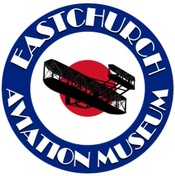Pilotless Aircraft (United States)

During World War 1, the United States Army aircraft board asked Charles Kettering to design an unmanned "flying bomb" which could hit a target at a range of about 40 miles. Kettering designed the machine - called the Kettering Aerial Torpedo - but it became known as the Kettering Bug.
Orville Wright was a consultant on the project, and so, having been the first person to put people into aircraft, here he was taking them out again only a few years later.
It was built by the Dayton-Wright Aeroplane Company. Elmer Ambrose Sperry designed the control and guidance systems.

Bug On Its Launch Trolley
The machine would lift from the trolley when it reached flying speed, just as the German V1 did. There were many failures.

Aviation Firsts at Eastchurch - Read Pioneers of Flight
There are many notable events......
The first Briton to fly a measured mile in a British built plane in the UK (J.T.C. Moore-Brabazon at Shellbeach in 1909).
The first airfield of the Aero Club of GB (1909) and then in 1910 the Royal Aero Club.
The sites that Wilbur and Orville Wright visited.
The research and development site of the magnificent Short Brothers (Oswald 1883-1969, Horace 1872-1917 and Eustace 1875-1932).
The birth (or at least the gestation) site of the RNAS (Royal Naval Air Service) AND of the Fleet Air Arm AND of the RAF Regiment.
The first aircraft (a Shorts S32) flown from a warship (HMS Africa 1912).
The site of the formation of the earliest squadrons to go the Western Front in WW1.
One of the first RAF stations.
The continuous service through WW1, the inter-war years and through WW2.
To commemorate the sites, the machines, the buildings and the people who worked and served here.
We also aim to be a research centre for anyone who wants to delve into the pioneer days of British aviation with a collection of works, books, prints, pictures, film, video, digital imaging and artefacts.
We have substantial plans for expansion, including the preservation of some hangars dating from 1912, which are, in the words of Historic England possibly the most important aviation architectural heritage in Europe or America.
If you have any experience or history of aviation on Sheppey, please share it with us, we have a thirst for knowledge and would be delighted if you can help us share it.
We look forward to seeing you at the museum.

Aircraft Over Eastchurch
Painting
About Eastchurch Aviation Museum
This website uses cookies.
We use cookies to analyze website traffic and optimize your website experience. By accepting our use of cookies, your data will be aggregated with all other user data.
